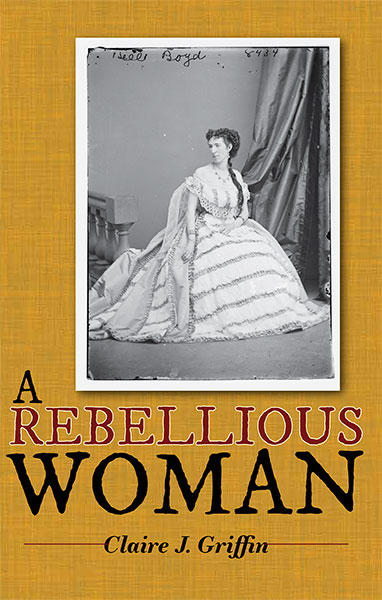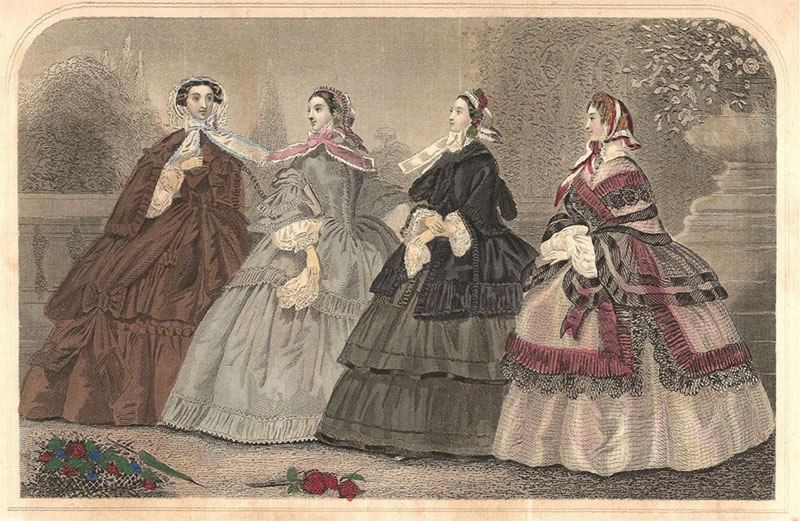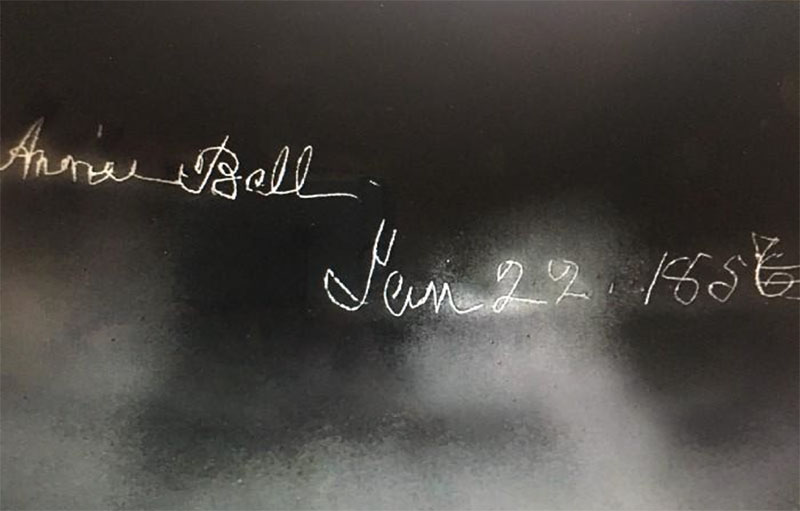A Rebellious Woman
A novel based on the life of the real Belle Boyd.
READ AN EXCERPT | BUY ON AMAZON
BUY ON BARNES AND NOBLE | BUY ON BOOKSHOP

Her life was her own.
At a time in American history when a woman’s only purpose was to be a well-behaved wife and mother, Belle Boyd stands out as a defiant female. Women of her day were kept in their place by strict etiquette rules that even dictated how they should eat bread at a dinner party. Layers of restrictive clothing along with easy access to opiates helped keep them passive and agreeable. Belle rejected rigid rules and roles, and insisted on making her own choices – sometimes with disastrous consequences. Still, no one can dispute the fact that Belle Boyd’s life was her own.

Interview with Claire J. Griffin at the Warren Heritage Society
A few words from the Author:
Podcast: Untold Civil War
Episode: A Rebellious Woman: The Spy Belle Boyd.
Podcast: HERstory on the Rocks
Bonus Episode: A Rebellious Woman by Claire J. Griffin
“Belle Boyd was daring in a highly visible way that scorned the era’s standards for ladies, and she took great advantage of the common assumption that a woman could not be dangerous.”
– National Women’s History Museum Website
Reviews
“An engaging and in places riveting story about Belle Boyd, the captivating young Confederate spy from Martinsburg, Virginia. Griffin captures Belle’s indomitable, energetic and forward-thinking spirit. She places Belle within the context of the culture and history of her era, particularly portraying everyday life during the Civil War in Martinsburg and Front Royal in a way one can see, hear, smell and feel.”
“A Rebellious Woman by Claire Griffin addresses a void in American history: the lack of authentic voices of women who defied social expectations from the 1840’s through 1900. It focuses on Belle Boyd, a compelling historical figure who charted her own course in life. It is rare to find such a well-researched work of historical fiction of a woman who chose to be an active participant in the tumultuous events unfolding around her and who forged a uniquely independent life through four decades. Griffin’s A Rebellious Woman brings this remarkable character to life with its attention to historical detail as well as the development of Belle’s character, from her early years as an irrepressible young girl in Martinsburg, Virginia, including her daring exploits as a spy, to her acting career and extensive travels throughout America, and, finally, to her death while she was still performing on stage in 1900 in Kilbourne, Wisconsin. Griffin’s Belle Boyd, in many ways, is a welcome antithesis to the portrayal of the stereotypical Southern belle. Her research revealed Belle’s many and varied accomplishments and experiences—an expert horsewoman, a spy, a prisoner of war, a domestic and world traveler, an author, a diseuse, and finally a woman who married three times and divorced twice, gaining and losing financial independence along the way. With A Rebellious Woman, Claire Griffin has written an American woman’s story that needed to be told.”
“A Rebellious Woman is a historical fiction biography of a remarkable woman who came to maturity just as the Civil War began and died a few decades later. Belle Boyd lived her whole life surrounded by the cult of genteel ladyhood. At times she used these constraints skillfully, and even unscrupulously, to gain her own controversial ends. But just as often she resisted conventional limitations, and astonishingly frequently, she had her way and did what she wished to do.
No Hollywood screen writer would dare to shape a plot so full of espionage, chase and escape, sex, melodrama and tragedy as the barest facts of Belle Boyd’s life. But this heroine pays heavily for flouting and undermining the rules of her gender and class. Griffin helps us to see these twists and contradictions, which make RW a great pick for a book club.
Griffin’s prose is lean and vivid and she gives us an honest, fully dimensioned picture of Boyd, including her blindness to the other great American system of oppression – slavery and racism. But we care about Belle, whose life unfolds in difficult and troubling ways, in spite of her gifts and courage. This complicated life raises timely questions and will provoke probing discussion.”
“While other Southern girls focused on husband-hunting and observing all the rules for social etiquette during the Civil War era, all Belle Boyd wanted was a chance to do her part for the Confederacy.
Author Claire Griffin tells the true story of Belle Boyd in A Rebellious Woman. In a time when women were thought to be too fragile to deal with serious matters like war, Belle proved that she was mistress of her own destiny. She used her feminine wiles to gather useful information to pass on and even spent time in prison. Based on her life experiences, she was known as someone who always charted her own path.
Throughout history, it’s ordinary people like Belle who are rarely recognized. I appreciate the author’s research into Belle’s life and decision to highlight her contributions. I found the author’s discussion questions at the end of the book to be thought-provoking, particularly a comparison between Belle and her maid, Eliza. While Eliza’s choices were limited because of her skin color, she and her family prospered over the course of the book. In contrast, Belle had complete freedom yet failed in a number of aspects.
With three marriages, two divorces, a stint in prison, and an acting career, Belle Boyd was quite an interesting woman. Kudos to the author for delivering a fresh face from history with A Rebellious Woman.”
“In this novel, author Claire J. Griffin weaves a thought-provoking story based on the life of the real Belle Boyd, a young woman who chafed at the constraints put upon American women during the 1800s. Belle yearns for a life where she can use her God-given talents to make a difference. The Civil War provides the perfect opportunity for Belle to assert herself and become an undercover spy for the Confederacy.
Griffin’s story mirrors that of the real Belle Boyd but has finely crafted fictional characters who help drive the plot. As the narrative begins, the state of Virginia is pro-slavery, while the western part of the state is more pro-Union. By 1863, West Virginia has become a new state, and Belle Boyd has become an essential link in the virtual spy network that helped the Confederacy.
Belle mingles with Union soldiers in residence near her home, then visits soldiers in Confederate camps. She works furtively to bring vital information to Stonewall Jackson to help the Southern cause. Eventually, she is arrested and sent to the infamous Old Capital Prison in Washington D.C. However, Belle can work her charms even in prison. She is finally paroled, the South loses the War, and Belle embarks on a new life that takes her on stage and into the limelight.
It is a thoroughly enjoyable book, obviously well researched, with good pacing and believable characters who find themselves pivotal agents in history. Other than a wish for some maps, I would highly recommend this novel.”
Read an Excerpt
 One of my first discoveries about Belle was this photograph of a name she had scratched into the window of a school building when she was a girl. I thought the photo was remarkable for several reasons.
One of my first discoveries about Belle was this photograph of a name she had scratched into the window of a school building when she was a girl. I thought the photo was remarkable for several reasons.
– Scratching one’s name into a windowpane was definitely not something a young lady in the 1850s was permitted to do. For a boy, such behavior might be excused, even expected. But the rules for girls were different. Yet here is clear evidence that twelve year old Belle was already breaking the rules for her gender.
– More amazing is that the name she carved wasn’t hers! There’s no doubt that it was Belle who did the carving. (She was one of the first students when the school building was brand new. The dates match her time there.) The name is not hers, but it is LIKE hers. It seems that even at this young age, she was already trying on different personalities, posing as someone she was not. A practice Belle would continue throughout her life.
This early sign of rebellion became the Prologue in the book. I can’t tell you how satisfying it was to describe an actual historical moment whose only record is a few scratches on a pane of glass. But to me those marks revealed the character and destiny of an actual flesh and blood woman whose extraordinary story it has been my pleasure to tell. – CJG
EXCERPT
Belle sat in her favorite window seat and stared out at the rain. A French grammar book lay open on her lap, but several minutes had passed since she had looked down at its pages. The other girls were gathered in one of the classrooms, painting pretty flowers on china plates. Belle had no patience for such feminine pursuits. Thank goodness they were not much stressed at Mt. Washington Female College.
Rain depressed Belle. It made her introspective, which she did not like at all. She would much rather feel her feelings than think about them. There seemed no reason at all to think about how you felt, as far as Belle was concerned. But a letter from her father had arrived at school that morning, asking if she was happy in her new term. And of course, dear Papa deserved an answer.
“Am I happy?” Belle wondered aloud, winding a ringlet of hair around her finger. “I suppose I am. For the moment.”
Last May, when she had turned twelve, Papa offered her the chance to go away to school. It was shortly after the incident in which Dame Havens, Belle’s former schoolmistress, had sent her least favorite pupil walking home through the streets of Martinsburg at ten in the morning, followed by Thomas, the dame’s slave, carrying Belle’s desk, schoolbook, slate, and chalk. Thomas had delivered Belle, her desk, etcetera to her surprised parents, along with a note listing Belle’s transgressions. Disrespect. Disobedience. Defiance. More etceteras.
Mama had grown teary at the contents of the note and at the very notion of her oldest daughter being paraded through the streets. Surely by now the whole town was talking about Belle. Again.
Papa had taken his daughter aside for a private conversation. Belle described the tedious lessons, the strict discipline, the whiny voice, the annoying sniff.
“Her nose drips, Papa.”
Ben Boyd had pressed his lips together.
Belle went on: “But mostly, it’s that I can’t stand being inside all day. It doesn’t suit me. I need to move about. I need to do things.”
Her father nodded. His expression was grave, lips set in a firm line. Yet when Belle searched his face, she thought she detected just the tiniest sparkle in his eyes.
After that conversation, nothing more was said. Still, something had to be done. Even Belle knew that.
A few months later, on her birthday, along with a dark blue sapphire ring that exactly matched her eyes, Papa had given Belle a brochure to read. Mt. Washington Female College claimed to be a forward-thinking institution whose mission was to educate young women by means of “thorough physical and intellectual training.”
She remembered Mama’s gifts too. A lace shawl, which Belle adored. And a copy of The Southern Ladies’ Book of Etiquette and Politeness. Belle loved Mama, but it was Papa who understood her. She had told him that the new school would do very nicely, thank you.
And that fall, Belle had headed off to Baltimore. She was accompanied by Eliza, aged twenty-three, who was as solid and steady as her young mistress was wayward and flighty. Eliza had been with the Boyd family since—well, since always, Belle realized, although Eliza had once belonged to Mama’s brother James. Papa and Mama trusted Eliza completely, and they had made it clear that among her other responsibilities, Eliza must prevent their headstrong daughter from repeating her earlier mistakes. Belle would be a lady!
So here she sat in the college’s main building, the octagonal one pictured in the school’s brochure, staring moodily through the drizzle at the damp grounds.
Belle decided she was happy. On the whole. She enjoyed learning history, French, literature, chemistry, and mathematics. The social arts were not neglected, and Belle was unusually accomplished at playing the piano, singing, and dancing. She took pride in being able to make conversation on a variety of topics, including current events, which she followed by reading all three of the Reverend’s daily newspapers. No, Belle didn’t mind in the least being hopeless at china painting, embroidery, and all the other activities reserved exclusively for ladies. She considered them pointless, stupid, and boring.
The director of the school, Reverend Staley, gave his charges considerable freedom. Belle used hers in various pursuits. Some of them forbidden. She was teaching Eliza to read! In secret, of course. It would have meant trouble for them both if they were found out. Even the Reverend’s liberal views might not extend as far as teaching a slave to read. Eliza learned amazingly fast, and Belle congratulated herself on her abilities as a teacher. She still didn’t know why she’d started teaching Eliza. Perhaps it was because she herself was being educated. More likely the reason was that it was forbidden. Belle was always tempted to break a rule she didn’t agree with. Why shouldn’t a slave know how to read?
Among all the freedoms at her school, the one Belle cared about most was being able to spend time outdoors. Reverend Staley thought the young women of his day were too prone to attacks of nerves, headaches, and fainting spells. His solution was regular physical exercise. His girls must leave the parlor and go outside to enjoy sunshine and fresh air. And so, whenever the weather was fine, there were games of croquet and badminton on the lawn. Mr. Abbott, their natural history teacher, took his students on long tramps across the fields and through the woods. Observing the changes of the seasons. Collecting specimens.
And then, of course, there was riding, which Belle loved more than anything in the world. Though one of the youngest pupils, she was the best horsewoman at the school. Unknown to her instructor, she sometimes rode astride, which delighted the few girls who were her friends and scandalized the many who were not.
Reverend Staley had proved most understanding of Belle’s boundless energy. During her first week at the school, in a fit of restlessness, she had left the grounds on her horse, been caught in a rainstorm, and gotten lost, returning hours later to a frantic staff. Wrapped in a blanket, a hot mug of tea in her hand, she had stood dripping on the Reverend’s carpet and been invited to explain herself. This was when she confessed to Dr. Staley that she was burdened with too much energy. She simply never grew tired! Afterward he had written her parents a letter admiring their daughter’s high spirits and vigorous good health. “Unusual in a female.”
Closing the book with a snap, Belle told herself she would go for a ride as soon as the weather cleared. But even that thought did little to lift her spirits, and she went back to twirling her hair.
A stray beam of sunlight broke through the clouds and flashed on her ring. Staring at the jewel, Belle’s eyes lit up. She slipped the ring off her finger and turned to face the window, long skirts bunching around her knees, her white-stockinged ankles exposed. Most unladylike. But Mama was not nearby to give a gentle reprimand.
Belle leaned toward the window, scratching the name and date into one of the panes. It was harder than she expected, difficult to grip the ring tightly enough to cut into the glass. She didn’t give up. Of course not. Belle never gave up. Not when she had set her mind to something.
When she finally finished and sat back to view her work, she giggled. She had done the name exactly as she intended. Annie Bell. Who cared if it wasn’t her own! Her real name of course was Maria Isabelle, but no one had ever called her that. No, it was the date that made her laugh. That was a true mistake. She’d forgotten that a new year had arrived three weeks past. It was no longer 1856. Leaning toward the glass, she scratched a 7 on top of the 6, then replaced the ring on her finger.
Belle read the name again and tossed her head. Quite right, she thought. No one would ever tell Belle who she would be. She intended to live her own life. Exactly as she chose.
Discussion Guide
Thank you for reading A Rebellious Woman. In the Discussion Guide you’ll find questions based on some of the thoughts I had while I was writing the book. – CJG



